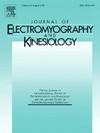在评估膝伸肌神经肌肉功能时,磁神经刺激的间歇可靠性和间歇内与电神经刺激的比较。
IF 2.3
4区 医学
Q3 NEUROSCIENCES
引用次数: 0
摘要
神经电刺激内插抽搐技术(ENS)被认为是评估自愿激活(VA)的金标准,但会引起不适。磁神经刺激(MNS)提供了一种无痛的替代方法,尽管其有效性和可靠性仍有待进一步研究。本研究在16名健康年轻人(11名女性)中验证了MNS到ENS的有效性,并评估了会话间可靠性。静息单次抽搐(RS)、最大自主收缩期间的叠加双次抽搐(ST)和静息双次抽搐(RT)的数据采用MNS和ENS以及不适评分(VAS)进行评估。使用类内相关性(ICC)、变异系数(CV)和平均绝对百分比误差(MAPE)来量化刺激和/或会话间可靠性之间的一致性。MNS和ENS对RS、RT和VA的检测结果非常一致(ICC = 0.77-0.88), MAPE值分别为4.4% (VA)和9.5% (RT)。MNS组的不适感(VAS = 1.0±0.9)低于ENS组(VAS = 1.9±1.1)。MNS的间歇信度较好(ICC = 0.78-0.95), VA的CV值较低(4.9%),RS、RT和ST的CV值较高(61.7%、28.9%、82.0%)。基于这些结果,MNS为评估膝关节伸肌VA提供了一种有效、可靠、无痛的替代ENS方法。然而,个体诱发的抽搐在不同的方法和会话中是不同的,在解释绝对值时需要谨慎。本文章由计算机程序翻译,如有差异,请以英文原文为准。
Inter-session Reliability of Magnetic Nerve Stimulation and Within-Session comparison to Electrical Nerve Stimulation in Evaluating Neuromuscular Function of Knee Extensor Muscles
The Interpolated Twitch Technique with electrical nerve stimulation (ENS) is the considered gold-standard to assess voluntary activation (VA) but causes discomfort. Magnetic nerve stimulation (MNS) offers a painless alternative, though its validity and reliability remain underexplored. This study validates MNS to ENS and evaluates inter-session reliability in 16 healthy young adults (11 females). Data on resting single twitches (RS), superimposed doublets (ST) during maximal voluntary contractions, and resting double twitches (RT) were assessed using both MNS and ENS, alongside discomfort ratings (VAS). Intraclass correlation (ICC), coefficient of variation (CV) and mean absolute percentage error (MAPE) were used to quantify agreement between stimulations and/or inter-session reliability. Strong agreement between MNS and ENS was found for RS, RT, and VA (ICC = 0.77–0.88), with MAPE values of 4.4 % (VA) and 9.5 % (RT). Discomfort was lower for MNS (VAS = 1.0 ± 0.9) than ENS (VAS = 1.9 ± 1.1). Intersession–reliability for MNS was good (ICC = 0.78–0.95) with low CV for VA (4.9 %) but high for RS, RT and ST (61.7 %, 28.9 %, 82.0 %). Based on these results, MNS provides a valid, reliable, and painless alternative to ENS for assessing VA in knee extensor muscles. However, individual evoked twitches varied across methods and sessions, warranting caution when interpreting absolute values.
求助全文
通过发布文献求助,成功后即可免费获取论文全文。
去求助
来源期刊
CiteScore
4.70
自引率
8.00%
发文量
70
审稿时长
74 days
期刊介绍:
Journal of Electromyography & Kinesiology is the primary source for outstanding original articles on the study of human movement from muscle contraction via its motor units and sensory system to integrated motion through mechanical and electrical detection techniques.
As the official publication of the International Society of Electrophysiology and Kinesiology, the journal is dedicated to publishing the best work in all areas of electromyography and kinesiology, including: control of movement, muscle fatigue, muscle and nerve properties, joint biomechanics and electrical stimulation. Applications in rehabilitation, sports & exercise, motion analysis, ergonomics, alternative & complimentary medicine, measures of human performance and technical articles on electromyographic signal processing are welcome.

 求助内容:
求助内容: 应助结果提醒方式:
应助结果提醒方式:


